
The Curtiss OX-5 was an early V-8 American liquid-cooled aircraft engine built by Curtiss. It was the first American-designed aircraft engine to enter mass production, although it was considered obsolete when it did so in 1917. It nevertheless found widespread use on a number of aircraft, perhaps the most famous being the JN-4 "Jenny". Some 12,600 units were built through early 1919. The wide availability of the engine in the surplus market made it common until the 1930s, although it was considered unreliable for most of its service life.
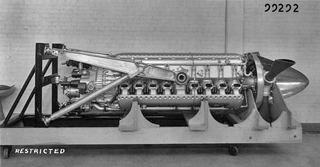
The Chrysler XIV-2220 was an experimental 2,500 hp, 2,220 cubic inch liquid-cooled inverted-V-16 aircraft engine designed by Chrysler starting in 1940. Although several aircraft designs had considered using it, by the time it was ready for use in 1945 the war was already over. Only a few engines were built during the program, and it retained its 'X' designation the entire time as the XIV-2220, later XI-2220. The IV-2220 is historically important as it was Chrysler's first hemi, a design that would re-appear for many years later and is now a Chrysler trademark.

The Rolls-Royce Kestrel is a 21.25 litre V-12 aircraft engine from Rolls-Royce. It was their first cast-block engine, and used as the pattern for most of their future piston-engine designs. Used during the interwar period, it was fitted to a number of British fighters and bombers of the era, including the Hawker Fury and Hawker Hart family, and the Handley Page Heyford. The Kestrel engine was also sold to international air force customers, in this role it used to power prototypes of the German Messerschmitt Bf 109 and the Junkers Ju 87 "Stuka" dive-bomber, as the Junkers Jumo 210 engines were not ready to be fitted. Several examples of the Kestrel engine remain airworthy today.
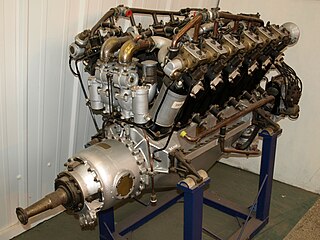
The Rolls-Royce Falcon is an aero engine developed in 1915. It was a smaller version of the Rolls-Royce Eagle, a liquid-cooled V-12 of 867 cu in capacity. Fitted to many British World War I-era aircraft, production ceased in 1927. The Falcon was designed by R.W. Harvey-Bailey.
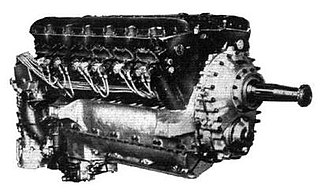
The Rolls-Royce Goshawk was a development of the Rolls-Royce Kestrel that used evaporative or steam cooling. In line with Rolls-Royce convention of naming piston engines after birds of prey, it was named after the goshawk.
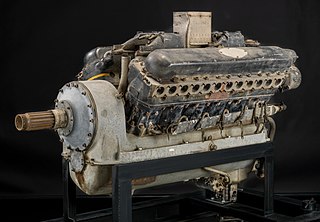
The Curtiss V-1570 Conqueror was a 12-cylinder vee liquid-cooled aircraft engine. Representing a more powerful version of the Curtiss D-12, the engine entered production in 1926 and flew in numerous aircraft.

The Allison V-3420 was a large experimental piston aircraft engine, designed in 1937 by the American Allison Engine Company.

The Macchi M.39 was a racing seaplane designed and built by the Italian aircraft company Aeronautica Macchi in 1925–26. An M.39 piloted by Major Mario de Bernardi (1893–1959) won the 1926 Schneider Trophy, and the type also set world speed records that year.
The Packard 1A-1500 was an American 12-cylinder liquid-cooled 60-degree Vee piston aircraft engine designed in 1924. Test flown in the second prototype Douglas XO-2 it proved to be unreliable. Only 29 engines were built.

The Ranger V-770 was an American air-cooled inverted V-12 aircraft engine developed by the Ranger Aircraft Engine Division of the Fairchild Engine & Aircraft Corporation in the early 1930s.
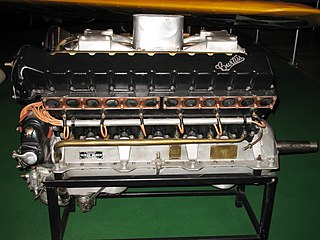
The Curtiss D-12, sometimes identified with the military designation Curtiss V-1150, was an aircraft engine of 18.8 liter displacement. It was a water-cooled V12, producing 443 hp (330 kW) and weighing 693 lb (314 kg). It was designed by Arthur Nutt in 1921 and used in the Curtiss CR-3 for the 1923 Schneider Trophy race. Fairey Aviation of England imported 50 Curtiss-built examples in 1926, renaming them the Fairey Felix.

The Hispano-Suiza 12X was an aircraft piston engine designed in France by Hispano-Suiza during the early 1930s. A 12-cylinder Vee, liquid-cooled design, the 12X was used on several aircraft types, some of them being used in limited numbers during World War II. Due to the 12X's limited power output, its derivative the more powerful Hispano-Suiza 12Y had a longer career.

The Fiat AS.6 was an unusual Italian 24-cylinder, liquid-cooled V configured aircraft racing engine designed and built in the late-1920s by Fiat especially for the Schneider Trophy air races, but development and running problems meant that it was never able to compete. Although the engine suffered from technical problems, it was later used to set a speed record for piston-powered seaplanes that still stands today.
The Fiat AS.5 was an Italian 12-cylinder, liquid-cooled V engine designed and built in the late-1920s by Fiat especially for the 1929 Schneider Trophy air race.

The Fiat AS.3 was an Italian 12-cylinder, liquid-cooled V engine designed and built in the mid-1920s by Fiat Aviazione especially for the 1927 Schneider Trophy air race.
The Hirth HM 512 was a 12-cylinder development of the earlier, 6-cylinder HM 506, produced in the late 1930s. Both were supercharged, inverted V, air-cooled engines.
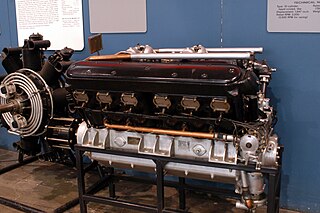
The Wright T-3 Tornado, also given the USAF designation Wright V-1950 was an American liquid-cooled aircraft piston engine, designed in the early 1920s.

The Fiat A.22 was an Italian water-cooled aircraft engine from the 1920s. It produced 425 kW (570 hp) and powered several absolute world distance records as well as commercial passenger flights.

The Hispano-Suiza 18R was an eighteen cylinder high performance water-cooled piston engine, in an 80° W or broad arrow layout, for use in racing aircraft, built in France during the latter half of the 1920s.

The Isotta Fraschini Asso Caccia, a.k.a. Isotta Fraschini Asso-450 Caccia, was an air-cooled, supercharged V12 piston aero engine produced in the late 1920s and early 1930s by Italian manufacturer Isotta Fraschini.

















